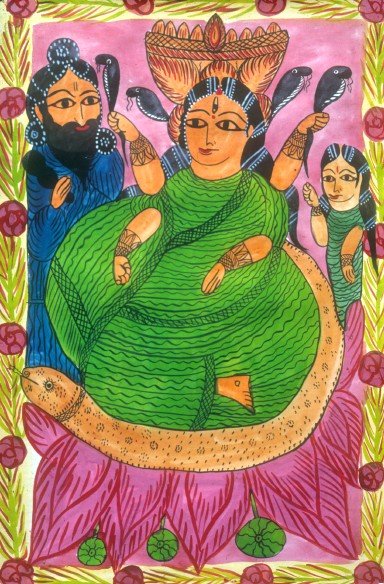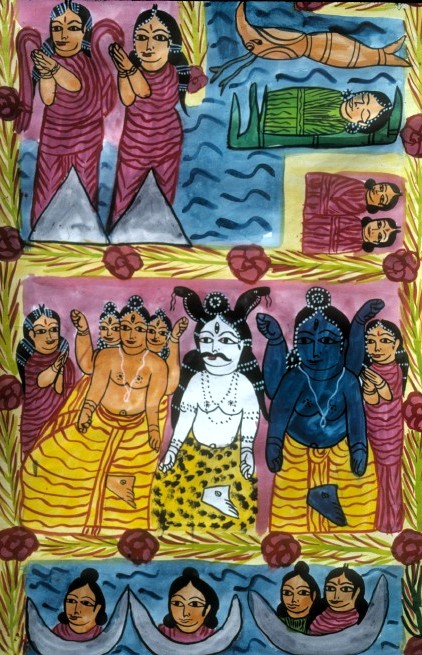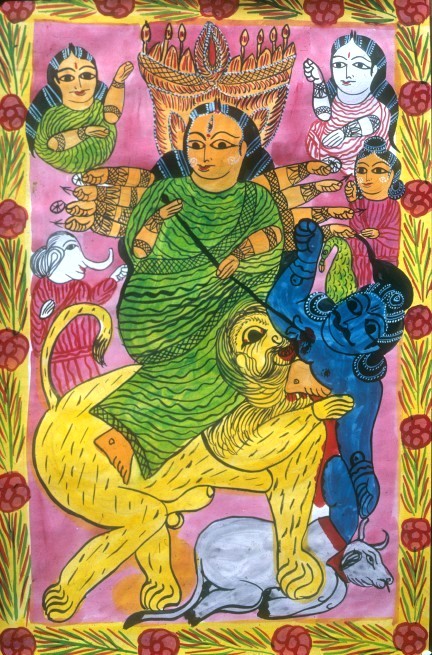Scroll Paintings in Lord Jagannath's Orissa
BY: ASIS K. CHAKRABARTI

Pataua Folk Painting, West Bengal
Feb 20, KOLKATA, WEST BENGAL (SUN) — A two-part review of the tradition of scroll paintings with special emphasis on Lord Jagannatha.
Folk art is an indivisible part of folk culture. The study of folk culture in the subcontinents of India dates back to the 19th century. Some eminent personalities or connoisseurs began to study folk culture absolutely to quench their personal interest. In this respect, the names of Dinesh Chandra, Sen. Reverend Lalbehari De, Ramendrasundar Trivedi, Rabindranath Tagore, Abanindranath Tagore and Gurusaday Dutt should be always mentioned. Of them, Gurusaday Dutt is the foremost pioneer in the field of collection, consequation and deliberation of folk art and culture in Orissa.
As quoted by the famous Bengali historian Nihar Ranjan Roy, Gurusaday Dutt had revealed the origin and flow of folk art and culture with the insight of an expert jeweller, who can easily identify a real stone.
Folk art has been defined in various ways and words. A thorough observation of the social, historical, geographical and cultural remains of the Indian subcontinent suggests that folk art is the art form created by the rural people for the rural people, which is centered round different kinds of folk and tribal religious rites, customs and festivals. The creation of folk art needs no grammatical norms set up by any ancient author of folk art and culture. The art form that is created by the spontaneity of a rural artist in the simplest possible way with the help of natural colours and ingredients may rightly be termed as folk art.
Antiquity of Scroll Painting: Historical Backdrop
Generally speaking, 'pattachitra' refers to an art form or painting created on paper or cloth. The literal meaning of the works 'pattachitra' or 'drawing of a patta' seems quite absurd, and this term might have been added later on, which is why, we find even in Tagore's songs - the words -
The word chitralekha has been in use for a very long time. In ancient India, the word 'chitra' signified hand-drawn pictures and inscriptions or sculpted out images. In that age, to differentiate hand-painted pictures from smeared or inscribed pictures, these were called written or "lekhya" pictures, and the practice of drawing was known as 'chitralekhan'. In spite of being unaware of the grammatical authenticity of the word 'chitralekha' (writing of a picture), the Patuas have coined the term 'pattalekha' (writing of a scroll). The word 'lekha' suggests a link of the Patuas with the ancient scroll painters.

According to the concept of folk paintings being executed by the folk painter, scrolls are written rather than drawn or painted by them. In Sanskrit, 'patta' means 'a cloth'. According to the history of Indian art, in ancient ages, pictures were 'pattachitra'. The creators of 'pattachitra' were introduced as the 'patuas'. On the basis of regional differences, the Patuas are classified as - pattikar, patkere, pattidar, mistry and so on.
However, the Patuas claim to have descended as a class belonging to 'Chitrakara', who had taken birth from celestial parents - the celestial artist, Vishwakarma and the celestial dancer, Ghritachi. Nowadays, art formS are not created on cloth, rather all the creations are produced on paper. Gazi Patta and Yama Patta, collected by Gurusaday Dutt, were made on cloth. These are now conserved in the Gurusaday Museum of Bratacharigram, Joka, Kolkata.
The Chitrakaras, or the scroll-painters, were mentioned in the 10th chapter of Brahmavaivarta Purana, written in the 11th or 12th century A.D. At a certain time, the celestial artist Vishwakarma descended from heaven and took birth in a Brahmin family. Simultaneously the celestial dancer, Ghritachi, took birth as the daughter of a gopa (milk producer) family. They got married and gave birth to nine sons: Malakara, Karmakara, Sankhakara, Kundibaka or Tantubayee, Kumbhakara, Kangsakara, Sutradhara, Chitrakara and Swarnakara.
According to the story, Vishwakarma and Ghritachi were the original parents or ancestors of the Patuas or Chitrakaras. In this regard, they are as honourable as any other artist or artisan of the Hindu society. In reality, however, Patuas are considered to be untouchable and ostracized. There is a myth behind this ostracism. An ancestor of the present day Patuas once drew the portrait of Mahadeva, the Great Lord of Hindu religion, without seeking His permission. After drawing the portrait, the artist was naturally very much annoyed and afraid as to what would happen if the Lord were to get angry with him. Incidentally, Mahadeva was just then coming by.
The painter hid the paint brush inside his mouth. Mahadeva asked the artist why had he made the brush unclean by keeping it inside his mouth. The Patua replied that he had done it out of fear. Mahadeva got angry and said that the Patua could have thrown it away. Instead he had made it unclean, so he had to accept the punishment. Then Mahadeva imprecated that from then on, the Patuas would be ostracized from the society.
They would neither be Hindus nor Muslims. They would have to perform Muslim rites and work like the Hindus, i.e., they would draw pictures and read or sing.
As far as history is concerned, this is the reason behind the ostracism of the Patuas due to the imprecation of Mahadeva. So the Patuas now go to Mosques like the Muslims and draws the pictures of Hindu deities, sculpt out their images and sing the praises of Hindu deities presented on the scrolls.

The reason for the ostracism of the Patua community has been mentioned in the Brahmavaivarta Purana. Since they had violated the rules of painting directed by the Brahman, the Brahmin society cursed them. As a consequence, they have been outcasted. So, both history and folklore suggest that violation of set up norms led to the ostracism of the Patuas. This fact is further supported by Parasurama's sloka:
"Vyati Kramena Chitranang Sadyashchitra Karashtta Patito Brahmo shapeno Brahmonanancho kopata"
Deviation from the normal art form has led the Patuas to be outcasted by the curse of the Brahmin society.
Regarding the ostracism of Patuas, Gurusaday Dutt pointed that the form of Bengal's generalized Hindu religion is quite separate from the scriptural religion devoted only to Brahma. The eternal, independent imaginative Bengali soul could not conform to a fixed regulation set up by the scripture while performing religions rites and creating images of deities. Rather, the Bengali Patuas have formed and moulded the images of deities according to their own imagination and expression. As a result, Bengal has its own forms of Rama, Sita, Laksmana, Shiva and Durga. They bear little similarity to their original historical forms.
The generalized form of Bengali Radha-Krishna does not conform to their corresponding historical or lila form. Bengali Patua's Sita-Rama are different in appearance and nature from their counterparts, mentioned and portrayed by Valmiki or Krittibasa. To reach the masses and to fulfill their heart's desire and imagination, the Patuas were courageous enough to violate the rules set up by the dominating Brahmin society even at the cost of their identity and existence. They have been bold enough to reflect Bengali sentiment and spirit in their songs, on their pattas and in the moulding of images of deities.

The Sun
News
Editorials
Features
Sun Blogs
Classifieds
Events
Recipes
PodCasts
About
Submit an Article
Contact Us
Advertise
HareKrsna.com
Copyright 2005, HareKrsna.com. All rights reserved.
